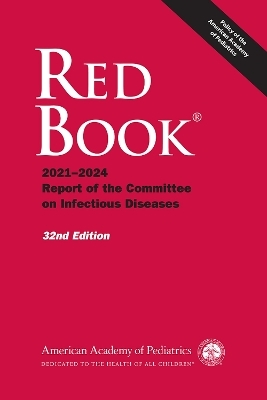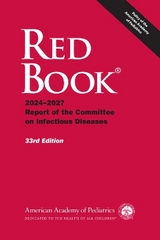
Red Book 2021-2024
American Academy of Pediatrics (Verlag)
978-1-61002-521-8 (ISBN)
Refer to the Red Book." That's been the watchword for generations of healthcare professionals seeking trustworthy guidance on pediatric infectious disease prevention, management, and control. Now the 32nd edition continues this tradition of excellence with the latest clinical guidance on manifestations, etiology, epidemiology, diagnosis and treatment of more than 200 childhood infectious diseases.
The 32nd edition provides evidence-based guidance on pediatric infections and vaccinations based on the recommendations of the committee as well as the combined expertise of the CDC, the FDA and hundreds of contributors.
Red Book is an indispensable reference for pediatricians and pediatric infectious disease specialists and is useful for family medicine and emergency medicine physicians, as well. Public health and school health professionals, medical residents, and students also will find it a high-yield source of pediatric infectious disease and vaccine information.
New in the 2021 Red Book:
All chapters were assessed for relevance in the dynamic environment that is the practice of medicine today, and every chapter has been modified.
Two chapters have been added to the 2021 edition: Pseudomonas aeruginosa Infections and a new "System-Based Treatment" table designed to aid in initial antibiotic selections by clinical conditions.
Standardized approaches to disease prevention through immunizations, antimicrobial prophylaxis, and infection-control practices have been updated throughout the Red Book
References to evidence-based policy recommendations have been updated throughout the Red Book.
Appropriate chapters throughout the Red Book have been updated to be consistent with 2021 AAP and CDC vaccine recommendations for immunization of health care personnel, and drug recommendations from 2021 Nelson's Pediatric Antimicrobial Therapy.
David W. Kimberlin, MD, FAAP is the Editor of the 2021 AAP Report of the Committee on Infectious Diseases (Red Book). He also was Editor of the 2015 and 2018 editions and was an Associate Editor of the 2012 and 2009 editions and served on the AAP Committee on Infectious Diseases from 2005- 2011. Dr Kimberlin is the Sergio Stagno, MD. Endowed Chair in Infectious Diseases, Professor and Co-Division Director, Vice Chair for Clinical and Translational Research. His clinical and research interests include pediatric infectious diseases, antiviral therapeutics in rare diseases with a large unmet medical need, including neonatal herpes simplex virus (HSV) infections, congenital cytomegalovirus (CMV) disease, congenital Zika infection, neonatal and infantile influenza infection, and neonatal enteroviral sepsis syndrome. Elizabeth D. Barnett, MD, FAAP is an Associate Editor of the 2021 Red Book and was a member on the Committee on Infectious Diseases from 2014 - 2020. Dr Elizabeth Barnett is Professor of Pediatrics at Boston University School of Medicine and Chief, Section of Pediatric Infectious Diseases in the Department of Pediatrics at Boston Medical Center. She leads the Refugee Health Assessment Program and the Pediatric Travel Clinic. Her clinical and research interests include vaccines and vaccine safety, refugee and immigrant medicine, travel medicine, and general pediatric infectious diseases. Ruth Lynfield, MD, FAAP is an Associate Editor of the 2021 Red Book and has been a member of the the Committee on Infectious Diseases since 2015. Dr Lynfield is the State Epidemiologist and Medical Director at the Minnesota Department of Health. She leads Minnesota's component of CDC's Emerging Infections Program Active Bacterial Core Surveillance System, influenza projects, and healthcare-associated infections projects. She is also Adjunct Professor of Medicine, and Epidemiology and Community Health at the University of Minnesota. Her clinical and research interests include pediatric infectious diseases, antimicrobial resistance and antimicrobial stewardship, emerging infections, prevention and control of infectious diseases, and outbreak response. Mark Sawyer, MD, FAAP is an Associate Editor of the 2021 Red Book and served on the Committee on Infectious Diseases from 2013- 2019. Dr Sawyer is an infectious disease specialist at Rady Children's Hospital and a professor of clinical pediatrics at UC San Diego. Additionally, Dr. Sawyer is vice chair for education in the UC San Diego Department of Pediatrics and the program director for the UC San Diego/Rady Children's Pediatric Residency Program and the medical director of the UC San Diego Immunization Partnership. His clinical and research interests include pediatric infectious diseases, medical education, training, and working with public health on the delivery of vaccines and national vaccine policy.
Summary of Major Changes in the 2018 Red Book,
Prologue,
Sources of Information About Immunization,
Discussing Vaccies With Patients and Parents,
Active Immunization,
Vaccine Ingredients,
Vaccine Handling and Storage,
Vaccine Administration,
Managing Injection Pain,
Immunization Schedule and Timing of Vaccines,
Minimum Ages and Minimum Intervals Between Vaccine Doses,
Interchangeability of Vaccine Products,
Simultaneous Administration of Multiple Vaccines,
Combination Vaccines,
Lapsed Immunizations,
Unknown or Uncertain Immunization Status,
Vaccine Dose,
Active Immunization of People Who Recently Received Immune Globulin and Other Blood Products,
Vaccine Safety (Risks and Adverse Events),
National Academy of Medicine Reviews of Adverse Events After Immunization,
Vaccine Adverse Event Reporting System (VAERS),
Vaccine Safety Datalink Project,
FDA CBER Sentinel Program: A Vaccine Surveillance System,
Clinical Immunization Safety Assessment (CISA) Project,
Vaccine Injury Compensation,
Hypersensitivity Reactions After Immunization,
Passive Immunization,
Immune Globulin Intramuscular (IGIM),
Immune Globulin Intravenous (IGIV),
Immune Globulin Subcutaneous (IGSC),
Treatment of Anaphylactic Reactions,
Immunization in Preterm and Low Birth Weight Infants,
Immunization in Pregnancy,
Immunization and Other Considerations in Immunocompromised Children,
Immunization in Children With a Personal or Family History of Seizure,
Immunization in Children With Chronic Diseases,
Immunization in American Indian/Alaska Native Children,
Immunization in Adolescent and College Populations,
Immunization in Health Care Personnel,
Children Who Received Immunizations Outside the US or Whose IZ Status is Unknown,
International Travel,
Human Milk,
Children in Group Child Care and Schools,
School Health,
Infection Control and Prevention for Hospitalized Children,
Infection Control and Prevention in Ambulatory Settings,
Sexually Transmitted Infections in Adolescents and Children,
Medical Evaluation for Infectious Diseases for Internationally Adopted, Refugee and Immigrant Children,
Injuries from Discarded Needles in the Community,
Bite Wounds,
Prevention of Mosquito Borne and Tick Borne Infections,
Prevention of Illnesses Associated With Recreational Water Use,
Actinomycosis,
Adenovirus Infections,
Amebiasis,
Amebic Meningoencephalitis and Keratitis,
Anthrax,
Arboviruses,
Arcanobacterium haemolyticum Infections,
Ascaris lumbricoides Infections,
Aspergillosis,
Astrovirus Infections,
Babesiosis,
Bacillus cereus Infections,
Bacterial Vaginosis,
Bacteroides and Prevotella and Other Anaerobic Gram-Negative Bacilli Infections,
Balantidium coli Infections (Balantidiasis),
Bartonella henselae (Cat-Scratch Disease),
Baylisascaris Infections,
Infections With Blastocystis hominis and Other Subtypes,
Blastomycosis,
Bocavirus,
Borrelia Infections Other Than Lyme Disease (Relapsing Fever),
Brucellosis,
Burkholderia Infections,
Campylobacter Infections,
Candidiasis,
Chancroid and Cutaneous Ulcers,
Chikungunya,
Chlamydial Infections, Chlamydophila pneumoniae,
Chlamydial Infections, Chlamydophila psittaci (Psittacosis, Ornithosis, Parrot Fever),
Chlamydial Infections, Chlamydia trachomatis,
Clostridial Infections, Botulism and Infant Botulism (Clostridium botulinum),
Clostridial Infections, Clostridial Myonecrosis (Gas Gangrene),
Clostridial Infections, Clostridioides difficile,
Clostridial Infections, Clostridium perfringens Foodborne Illness,
Coccidiodomycosis,
Coronaviruses, Including SARS-CoV-2 and MERS-CoV,
Cryptococcus neoformans and Cryptococcus gattii Infections,
Cryptosporidiosis,
Cutaneous Larva Migrans,
Cyclosporiasis,
Cystoisosporiasis (formerly Isosporiasis),
Cytomegalovirus Infection,
Dengue,
Diphtheria,
Ehrlichia, Anaplasma, and Related Infections (Human Ehrlichiosis, Anaplasmosis, and Related Infections Attributable to Bacteria in the Family Anaplasmataceae),
Serious Bacterial Infections Caused by Enterobacteriaceae (With Emphasis on Septicemia and Meningitis in Neonates),
Enterovirus (Nonpoliovirus) (Group A and B Coxsackieviruses, Echoviruses, Numbered Enteroviruses),
Epstein-Bar Virus Infections (Infectious Mononucleosis),
Escherichia coli Diarrhea (Including Hemolytic-Uremic Syndrome),
Fungal Diseases,
Fusobacterium Infections (Including Lemierre Disease),
Giardia duodenalis (formerly Giardia lamblia and Giardia intestinalis) Infections (Giardiasis),
Gonococcal Infections,
Granuloma Inguinale (Donovanosis),
Haemophilus influenzae Infections,
Hantavirus Pulmonary Syndrome,
Helicobacter pylori Infections,
Hemorrhagic Fevers Caused by Arenaviruses,
Hemorrhagic Fevers Caused by Bunyaviruses,
Hemorrhagic Fevers Caused by Filoviruses: Ebola and Marburg,
Hepatitis A ,
Hepatitis B,
Hepatitis C,
Hepatitis D,
Hepatitis E,
Herpes Simplex,
Histoplasmosis,
Hookworm Infections (Ancylostoma duodenale and Necator americanus),
Human Herpesvirus 6 (Including Roseola) and 7,
Human Herpesvirus 8,
Human Immunodeficiency Virus Infection,
Influenza,
Kawasaki Disease,
Kingella kingae Infections,
Legionella pneumophila Infections,
Leishmaniasis,
Leprosy,
Leptospirosis,
Listeria monocytogenes Infections (Listeriosis),
Lyme Disease (Lyme Borreliosis, Borrelia burgdorferi sensu lato Infection),
Lymphatic Filariasis (Bancroftian, Malayan, and Timorian),
Lymphocytic Choriomeningitis Virus,
Malaria,
Measles,
Meningococcal Infections,
Human Metapneumovirus,
Microsporidia Infections (Microsporidiosis),
Molluscum Contagiosum,
Moraxella catarrhalis Infections,
Mumps,
Mycoplasma pneumoniae Infections,
Nocardiosis,
Norovirus and Sapovirus Infections,
Onchocerciasis (River Blindness, Filariasis),
Human Papillomavirus,
Paracoccidioidomycosis (Formerly Known as South American Blastomycosis),
Paragonimiasis,
Parainfluenza Viral Infections,
Parasitic Diseases,
Parechovirus Infections (Formerly Human Parechovirus Infections),
Parvovirus B19 (Erythema Infectiosum, Fifth Disease),
Pasteurella Infections,
Pediculosis Capitis (Head Lice),
Pediculosis Corporis (Body Lice),
Pediculosis Pubis (Pubic Lice, Crab Lice),
Pelvic Inflammatory Disease,
Pertussis (Whooping Cough),
Pinworm Infection (Enterobius vermicularis),
Pityriasis Versicolor (Tinea Versicolor),
Plague,
Pneumococcal Infections,
Pneumocystis jirovecci Infections,
Poliovirus Infections,
Polyomaviruses (BK, JC, and Other Polyomaviruses),
Prion Diseases: Transmissible Degenerative Encephalopathies,
Q Fever (Coxiella burnetti Infections),
Rabies,
Rat-Bite Fever,
Respiratory Syncytial Virus,
Rhinovirus Infections,
Rickettsial Diseases,
Rickettsialpox,
Rocky Mountain Spotted Fever,
Rotavirus Infections,
Rubella,
Salmonella Infections,
Scabies,
Schistosomiasis,
Shigella Infections,
Smallpox (Variola),
Sporotrichosis,
Staphylococcal Food Poisoning,
Staphylococcus aureus,
Coagulase-negative Staphylococcal Infections,
Group A Streptococcal Infections,
Group B Streptococcal Infections,
Non-Group A or B Streptococcal and Enterococcal Infections,
Strongyloidiasis (Strongyloides stercoralis),
Syphilis,
Tapeworm Diseases (Taeniasis and Cysricercosis),
Other Tapeworm Infections (Including Hyatid Disease),
Tetanus (Lockjaw),
Tinea Capitis (Ringworm of the Scalp),
Tinea Corporis (Ringworm of the Body),
Tinea Cruris (Jock Itch),
Tinea Pedis and Tinea Unguium (Onychomycosis) (Athlete’s Foot, Ringworm of the Feet),
Toxocariasis (Visceral Toxocariasis [a Form of Visceral Larva Migrans], Ocular Toxocariasis [a Form of Ocular Larva Migrans]),
Toxoplasma gondii Infections (Toxoplasmosis),
Trichinellosis (Trichinella spiralis and Other Species),
Trichomonas vaginalis Infections (Trichomoniasis),
Trichuriasis (Whipworm Infection),
African Trypanosomiasis (African Sleeping Sickness),
American Trypanosomiasis (Chagas Disease),
Tuberculosis,
Nontuberculous Mycobacteria (Environmental Mycobacteria, Mycobacteria Other Than Mycobacterium tuberculosis),
Tularemia,
Endemic or Flea Borne Typhus),
Epidemic Typhus (Louseborne or Sylvatic Typhus),
Ureaplasma urealyticum and Ureaplasma parvum Infections,
Varicella-Zoster Infections,
Vibrio Infections, Cholera (Vibrio cholerae),
Vibrio Infections, Other Vibrio Infections,
West Nile Virus,
Yersinia enterocolitica and Yersinia pseudotuberculosis Infections (Enteritis and Other Illnesses),
Zika Virus,
Antimicrobial Agents and Related Therapy,
Antimicrobial Resistance and Antimicrobial Stewardship: Appropriate and Judicious Use of Antimicrobial Agents,
Drug Interactions,
Tables of Antibacterial Drug Doses,
Sexually Transmitted Infections,
Antifungal Drugs for Systemic Fungal Infections,
Recommended Doses of Parenteral and Oral Antifungal Drugs,
Topical Drugs for Superficial Fungal Infections,
Non-HIV Antiviral Drugs,
Drugs for Parasitic Infections,
MEDWATCH-The FDA Safety Information and Adverse Event Reporting Program,
Antimicrobial Prophylaxis,
Antimicrobial Prophylaxis in Pediatric Surgical Patients,
Prevention of Bacterial Endocarditis,
Neonatal Ophthalmia,
Directory of Resources,
Codes for Commonly Administered Pediatric Vaccines/Toxoids and Immune Globulins,
Vaccine Injury Table,
Nationally Notifiable Infectious Diseases in the United States,
Guide to Contraindications and Precautions to Immunizations,
Prevention of Infectious Disease From Contaminated Food Products,
Clinical Syndromes Associated With Foodborne Diseases,
Diseases Transmitted by Animals (Zoonoses)
| Erscheinungsdatum | 16.06.2021 |
|---|---|
| Mitarbeit |
Stellvertretende Herausgeber: Elizabeth Barnett, Ruth Lynfield, Mark H. Sawyer |
| Verlagsort | Elk Grove Village |
| Sprache | englisch |
| Maße | 151 x 230 mm |
| Gewicht | 1408 g |
| Themenwelt | Medizin / Pharmazie ► Gesundheitswesen |
| Medizin / Pharmazie ► Medizinische Fachgebiete ► Pädiatrie | |
| Studium ► Querschnittsbereiche ► Infektiologie / Immunologie | |
| ISBN-10 | 1-61002-521-0 / 1610025210 |
| ISBN-13 | 978-1-61002-521-8 / 9781610025218 |
| Zustand | Neuware |
| Haben Sie eine Frage zum Produkt? |
aus dem Bereich



